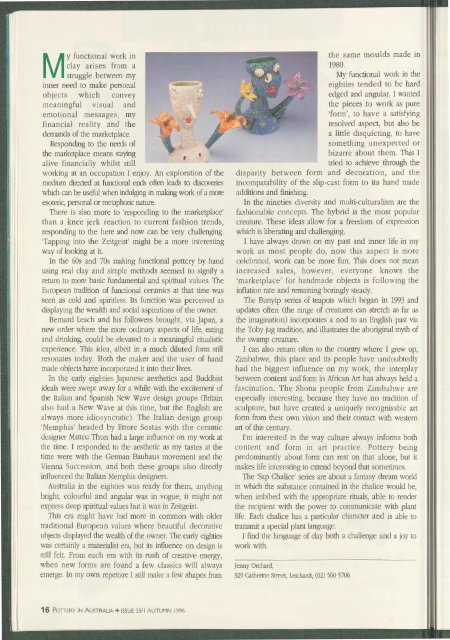Pottery In Australia Vol 35 No 1 Autumn 1996
You also want an ePaper? Increase the reach of your titles
YUMPU automatically turns print PDFs into web optimized ePapers that Google loves.
M<br />
y functional work in<br />
clay arises from a<br />
struggle between my<br />
inner need to make personal<br />
objects which convey<br />
meaningful visual and<br />
emotional messages, my<br />
financial reality and the<br />
demands of the marketplace.<br />
Responding to the needs of<br />
the marketplace means staying<br />
alive financially whilst still<br />
working at an occupation I enjoy. An exploration of the<br />
medium directed at functional ends often leads to discoveries<br />
which can be useful when indulging in making work of a more<br />
esoteric, personal or metaphoric nature.<br />
There is also more to 'responding to the marketplace'<br />
than a knee jerk reaction to current fashion trends,<br />
responding to the here and now can be very challenging.<br />
'Tapping into the Zeitgeist' might be a more interesting<br />
way of looking at it.<br />
<strong>In</strong> the 60s and 70s making functional pottery by hand<br />
using real clay and simple methods seemed to signify a<br />
return to more basic fundamental and spiritual values. The<br />
European tradition of functional ceramics at that time was<br />
seen as cold and spiritless. Its function was perceived as<br />
displaying the wealth and social aspirations of the owner.<br />
Bernard Leach and his followers brought, via Japan, a<br />
new order where the more ordinary aspects of life, eating<br />
and drinking, could be elevated to a meaningful ritualistic<br />
experience. This idea, albeit in a much diluted form still<br />
resonates today. Both the maker and the user of hand<br />
made objects have incorporated it into their lives.<br />
<strong>In</strong> the early eighties Japanese aesthetics and Buddhist<br />
ideals were swept away for a while with the excitement of<br />
the Italian and Spanish New Wave design groups (Britain<br />
also had a New Wave at this time, but the English are<br />
always more idiosyncratic). The Italian design group<br />
'Memphis' headed by Ettore Sostas with the ceramic<br />
designer Matteu Thun had a large influence on my work at<br />
the time. I responded to the aesthetic as my tastes at the<br />
time were with the German Bauhaus movement and the<br />
Vienna Succession, and both these groups also directly<br />
influenced the Italian Memphis designers.<br />
<strong>Australia</strong> in the eighties was ready for them, anything<br />
bright, colourful and angular was in vogue, it might not<br />
express deep spiritual values but it was in Zeitgeist.<br />
This era might have had more in common with older<br />
traditional European values where beautiful decorative<br />
objects displayed the wealth of the owner. The early eighties<br />
was certainly a materialist era, but its influence on design is<br />
still felt. From each era with its rush of creative energy,<br />
when new forms are found a few classics will always<br />
emerge. <strong>In</strong> my own repetoire I still make a few shapes from<br />
,<br />
the same moulds made in<br />
1980.<br />
My functional work in the<br />
eighties tended to be hard<br />
edged and angular. I wanted<br />
the pieces to work as pure<br />
'form', to have a satisfying<br />
resolved aspect, but also be<br />
a little disquieting, to have<br />
something unexpected or<br />
bizarre about them. This I<br />
tried to achieve through the<br />
disparity between form and decoration, and the<br />
incompatability of the slip-cast form to its hand made<br />
additions and finishing.<br />
<strong>In</strong> the nineties diversity and multi-culturalism are the<br />
fashionable concepts. The hybrid is the most popular<br />
creature. These ideas allow for a freedom of expression<br />
which is liberating and challenging.<br />
I have always drawn on my past and inner life in my<br />
work as most people do, now this aspect is more<br />
celebrated, work can be more fun. This does not mean<br />
increased sales, however, everyone knows the<br />
'marketplace' for handmade objects is following the<br />
inflation rate and remaining boringly steady.<br />
The Bunyip series of teapots which began in 1993 and<br />
updates often (the range of creatures can stretch as far as<br />
the imagination) incorporates a nod to an English past via<br />
the Toby jug tradition, and illustrates the aboriginal myth of<br />
the swamp creature.<br />
I can also return often to the country where I grew up,<br />
Zimbabwe, this place and its people have undoubtedly<br />
had the biggest influence on my work, the interplay<br />
between content and form in African Art has always held a<br />
fascination. The Shona people from Zimbabwe are<br />
especially interesting, because they have no tradition of<br />
sculpture, but have created a uniquely recognisable art<br />
fonn from their own vision and their contact with western<br />
art of this century.<br />
I'm interested in the way culture always informs both<br />
content and form in art practice. <strong>Pottery</strong> being<br />
predominantly about form can rest on that alone, but it<br />
makes life interesting to extend beyond that sometimes.<br />
The 'Sap Chalice' series are about a fantasy dream world<br />
in which the substance contained in the chalice would be,<br />
when imbibed with the appropriate rituals, able to render<br />
the recipient with the power to communicate with plant<br />
life. Each chalice has a particular character and is able to<br />
transmit a special plant language.<br />
I find the language of clay both a challenge and a joy to<br />
work with.<br />
Jenny Orchard,<br />
329 Catherine Street, Leichardt, (02) 560 5706<br />
16 POTTERY IN AUSTRALIA + ISSUE <strong>35</strong>/ I AUTUMN <strong>1996</strong>

















